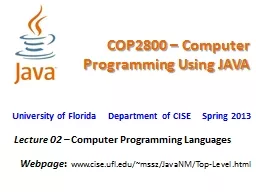

University of Florida Department of CISE Spring 2013 Lecture 02 Computer Programming Languages Webpage wwwciseufledumsszJavaNMTopLevelhtml COP2800 Programming in JAVA ID: 782565
Download The PPT/PDF document "COP2800 – Computer Programming Using J..." is the property of its rightful owner. Permission is granted to download and print the materials on this web site for personal, non-commercial use only, and to display it on your personal computer provided you do not modify the materials and that you retain all copyright notices contained in the materials. By downloading content from our website, you accept the terms of this agreement.
Slide1
COP2800 – Computer Programming Using JAVA
University of Florida Department of CISE Spring 2013 Lecture 02 – Computer Programming LanguagesWebpage: www.cise.ufl.edu/~mssz/JavaNM/Top-Level.html
Slide2COP2800 – Programming in JAVACourse Objectives
Basic Knowledge of Computers & ProgrammingSpecific Knowledge of JAVA ProgrammingPractical Programming Projects Build SkillsToday’s ClassProgramming LanguagesHistoryObject Oriented Programming (OOPs)Example: “Hello, world!”
Slide3Review: What is a Computer?
Machine that Changes Its StateHow is State Represented?Zeroes and Ones : 0010101011000101101…Called a “State Map”Computer Hardware (HW) is EquipmentCPU, Memory, Mouse, Printer, Flat-Panel Display…Hardware Must Be Controlled by Software (SW)
Slide4How Computer Programming Works
JAVA
Slide5JAVA: Write Once, Run AnywherePortable
= More EconomicalWrite one JAVA Application : Don’t Need to Reprogram Every Time New HW is AcquiredRuns on any JVM/JRERuns on Web (Javascript) as Applet
Slide6Computer Circuit Technology
Vacuum Tubes (Gen-1)Transistors (Gen-2)Integrated Circuits (Gen-3)Very Large-Scale Integration (Gen-4)
Large, Hot, Failure-Prone
Power-Consumptive (not
Green
)
Smaller, Cooler, More Reliable
Less Power-Consumptive
Smaller, Faster, Less Power
Smaller, Faster, Less Power
Many More
Transistors
Packed onto
a Chip
Slide7In The Beginning…1940s Vacuum Tube Computers (Gen-1)
ENIAC Computer
(vacuum-tube calculator)
Plugboard
Programming
(
spaghettiware
)
COMPUTER HARDWARE COMPUTER PROGRAMMING
Slide8Machine Code
1950s Vacuum Tube Computers (Gen-1)
IBM 709 Computer
(stored-program)
Machine Language Programming
COMPUTER HARDWARE COMPUTER PROGRAMMING
Slide9Assembly LanguageEarly 1960s Transistorized Computers (Gen-2)
IBM 7090
(scientific computer)
Assembly Language Program
COMPUTER HARDWARE COMPUTER PROGRAMMING
Slide10High-Level Language (HLL)Mid 1960s Transistorized Computers (Gen-2)
IBM System/360
(interoperable)
HLL Program (COBOL)
COMPUTER HARDWARE COMPUTER PROGRAMMING
Slide11Integrated Circuits (ICs)Early 1970s IC-Based Computers (Gen-3)
IBM System/370
(interoperable)
HLL Program (PL/1)
COMPUTER HARDWARE COMPUTER PROGRAMMING
Slide12Very Large-Scale Integration
IBM PC
Apple Macintosh
HLL Program (JAVA language)
COMPUTER HARDWARE COMPUTER PROGRAMMING
1980s/1990s VLSI-Based Computers (Gen-4)
Workstation
Slide13Very Large-Scale Integration (cont’d)
Intel Ivy Bridge
Multicore
CPU
Nvidia
Tesla C2090 GPU
Central Processing Unit (CPU) Graphics Processing Unit (GPU)
2010s VLSI-Based “Supercomputer-on-a-Chip”
Billions of Transistors Per Chip
Slide14Computer Interfaces & Output
1940s-50s: Typewriter Output
1960s: Line Printer Output
1970s: Graphics Terminal
1980s ff: Graphical User Interface
with Hi-Resolution Display
Slide15Future Computing HW Technologies
Cortically Controlled Computers Optical Computer Uses
Lightwaves
Faster, More Interactive Computers
Mobile, Network-Connected Computers
Slide16Computer Programming Technologies
Not as Much Change As HW
Slow Programming Process
Error-Prone Code Entry
Compiler errors
Still Need Assembly Language
Modern SW Development Tools: Interactive, Virtual
Slide17Computer Programming Language
Example:
“Hello, world!”
1950s:
COBOL
1960s:
FORTRAN
1970s:
Pascal
1970s-present:
C language
2000s:
JAVA
Assignment: Read the Webpage
http://en.wikipedia.org/wiki/Hello_world_program_examples
Slide18Computer Programming Tools
Assignment
:
To Be Done by Friday
Request a CISE
class
account
per the instructions on this
Web page:
http
://www.cise.ufl.edu/help/account.shtml
This
will allow
you to run and check your programs
on the same machines we use to grade them.
Slide19Computer Programming Tools
Next Class (Friday)
Overview of JAVA Programming Language
Access JAVA Programming Tools
Download JAVA Tools to Your Laptop
Write a “Hello, world!” Program
Run the Program
Bring Your Laptops